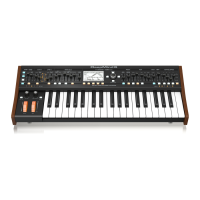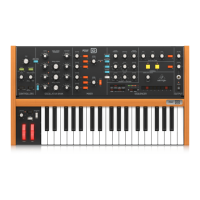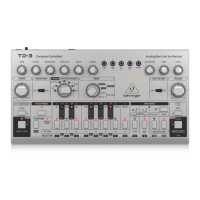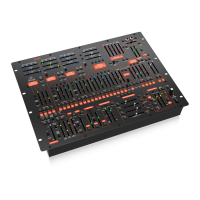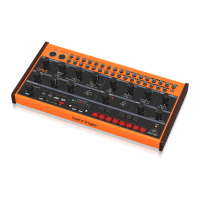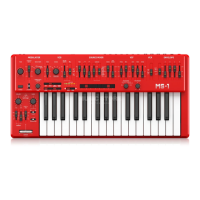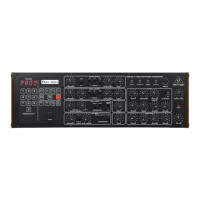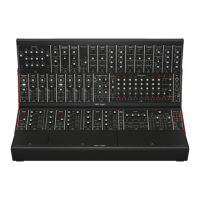100 DeepMind 12 User Manual
Phaser
A Stereo Phaser, or phase shifter, applies multiple STAGES of modulated lters to
the input signal to create a “notch” in the frequency response, and then applies
a MIX with the original for a “swirling” eect. Use the Stereo Phaser to add a
“spaced-out” sound to vocal or instrument tracks.
SPEED adjusts the LFO rate and DEPTH sets the LFO modulation depth. The BASE
knob adjusts the frequency range of the modulated lters. The resonance is
adjusted with the RES knob. The WAVE knob shapes the symmetry of the LFO
waveform and PHASE dials in an LFO phase dierence between the left and
right channel. The modulation source can also be the signal envelope, which
produces vowel-like opening and closing tones. The ENV knob adjusts how much
this eect takes place (positive and negative modulation is possible), and the
ATTACK, HOLD and RELEASE knobs all tailor the response of this feature.
Mood Filter
The Mood Filter uses an LFO generator and an auto-envelope generator to
control a VCF (voltage-controlled lter), as well as a side chain function where
the channel B signal controls the envelope of channel A.
This lter can be modulated with the signal’s envelope using the ENV MOD
(withpositive and negative amounts), ATTACK and RELEASE knobs, or the
LFOcan modulate the lter. The WAVE knob selects between 7 dierent wave
forms–triangular, sine, saw plus, saw minus, ramp, square, and random.
ThePHASE can be o set by up to 180 degrees. The SPEED knob adjusts the rate
of the LFOand the DEPTH adjusts the amount of LFO modulation. Adjustthe
resonance of the lter until self-oscillation with the RESO(nance) knob.
BASEadjusts the range of the lter from 20 Hz to 15 kHz. The MODE switch
selects between low pass (LP), high-pass (HP), band-pass (BP) and Notch. Use
the MIXknob to blend the eected signal with the dry sound. With the 4 POLE
switch engaged, there will be a steeper slope than the OFF (2 pole) setting. The
DRIVE knob adjusts the level and can also introduce an overdrive eect (as with
real analog lters) if pushed hard.
Stereo / Dual Pitch
Pitch shifting is often used in two dierent ways. One is to set the Mix knob
lower and only use the Cent knob to make a small o set in pitch between the
wet and dry tones. This results in a “voice doubling” eect that thickens the
overall sound in a more subtle way. The extreme use of the eect is to turn the
Mix knob fully clockwise so the entire signal is eected. This way, the signal can
be shifted into other keys up to an octave above or below the original. When
used on a voice, this results in a “chipmunk” sound or a low Darth Vader eect.
When the SEMI and CENT knobs are set at 12:00, the pitch is not altered.
Makingadjustments by semitone will have a very pronounced eect,
whereaschanges to the CENT knob will be very minor. The DELAY knob creates
a time dierence between the wet and dry sound. The LO and HI CUT knobs
allow the eected signal to be band-limited. The Dual Pitch eect allows
the leftandright channels to be adjusted independently, and allows GAIN
compensation andpanning of the two channels.
Note: If you notice any "glitching" that may occur when using low-level signals,
we recommend using the Vintage Pitch FX shown below.
Vintage Pitch
Pitch shifting is often used in two dierent ways. One is to set the Mix knob lower
and only use the Cent knob to make a small o set in pitch between the wet and
dry tones. This results in a “voice doubling” eect that thickens the overall sound
in a more subtle way. The extreme use of the eect is to turn the Mix knob fully
clockwise so the entire signal is eected. This way, the signal can be shifted into
other keys up to an octave above or below the original. When used on a voice,
this results in a “chipmunk” sound or a low Darth Vader eect.
When the SEMI and CENT knobs are set at 12:00, the pitch is not altered.
Makingadjustments by semitone will have a very pronounced eect,
whereaschanges to the CENT knob will be very minor. The DELAY knob creates
a time dierence between the wet and dry sound. The LO and HI CUT knobs
allow the eected signal to be band-limited. The Dual Pitch eect allows the
leftandright channels to be adjusted independently, and allows FEEDBACK
andpanning of the two channels.
Rotary Speaker
Rotary Speaker emulates the sound of a Leslie rotating speaker. The Rotary
Speaker provides more exibility than its electromechanical counterpart, andcan
be used with a variety of instruments, and even vocals, to create a whirling,
psychedelic eect.
The LO SPEED and HI SPEED knobs adjust the rotational speed of the
SLOWand FAST Speed selection, and can be toggled with the FAST switch.
TheACCEL(eration) knob adjusts how quickly the speed increases and
decreases from the Slow mode to the Fast mode. The rotation eect can also
be disengaged with the STOP switch, which will stop the movement of the
speakers. DISTANCEadjusts the distance between the Rotary speakers and the
virtualmicrophone.

